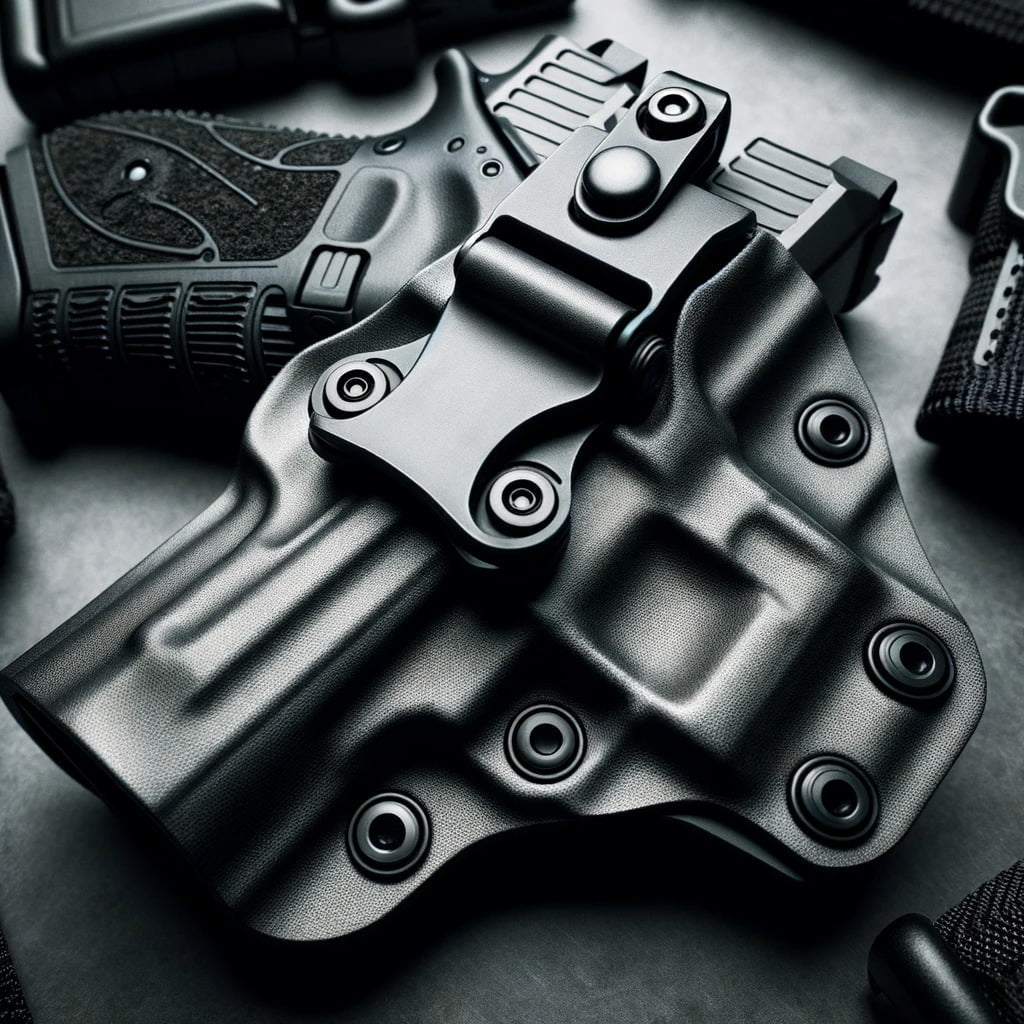What is a Retention Holster?
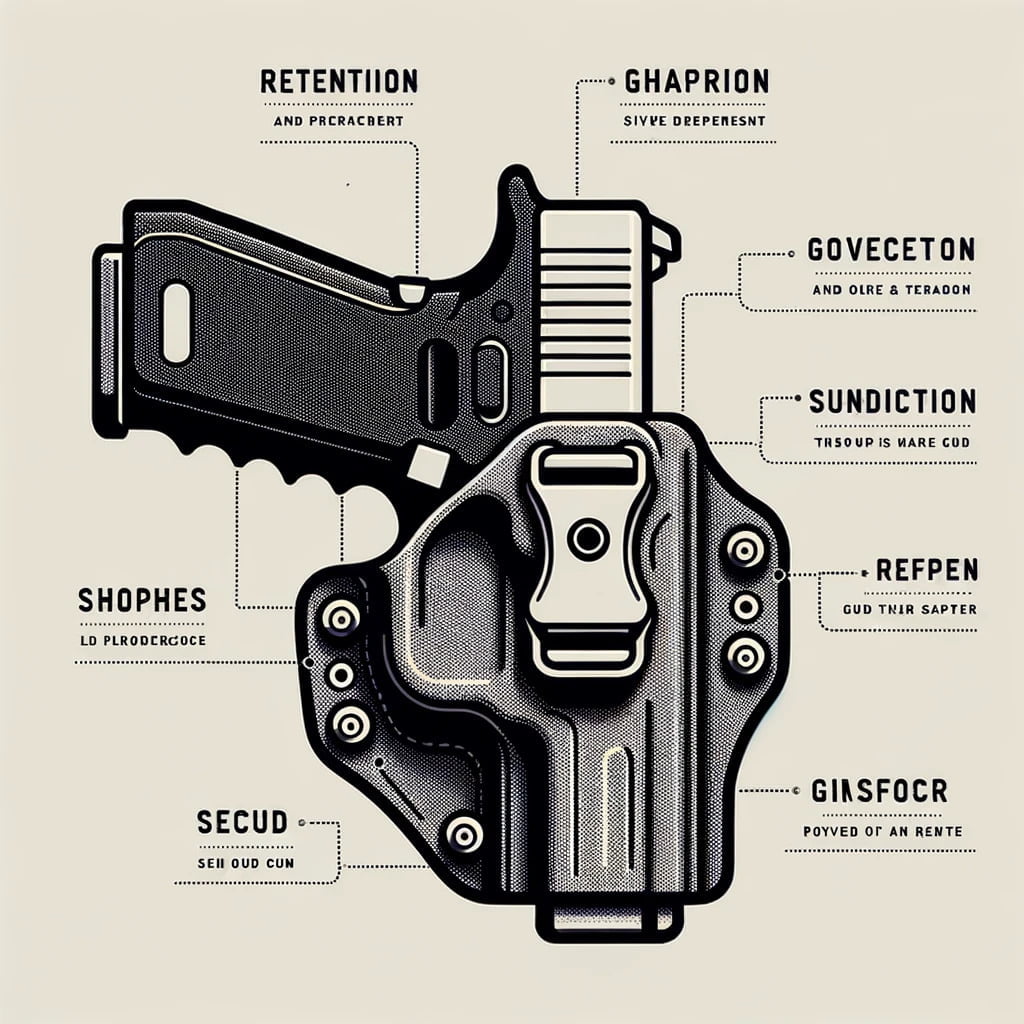
A holster is essentially a specially designed holder for carrying a handgun, typically made of leather or synthetic materials. It’s a tool that allows the user to securely and conveniently carry a firearm, either concealed or openly. The term “retention” in “retention holster” refers to the holster’s ability to securely hold the firearm in place, preventing it from falling out or being easily grabbed by someone else.
History and Evolution of Holsters
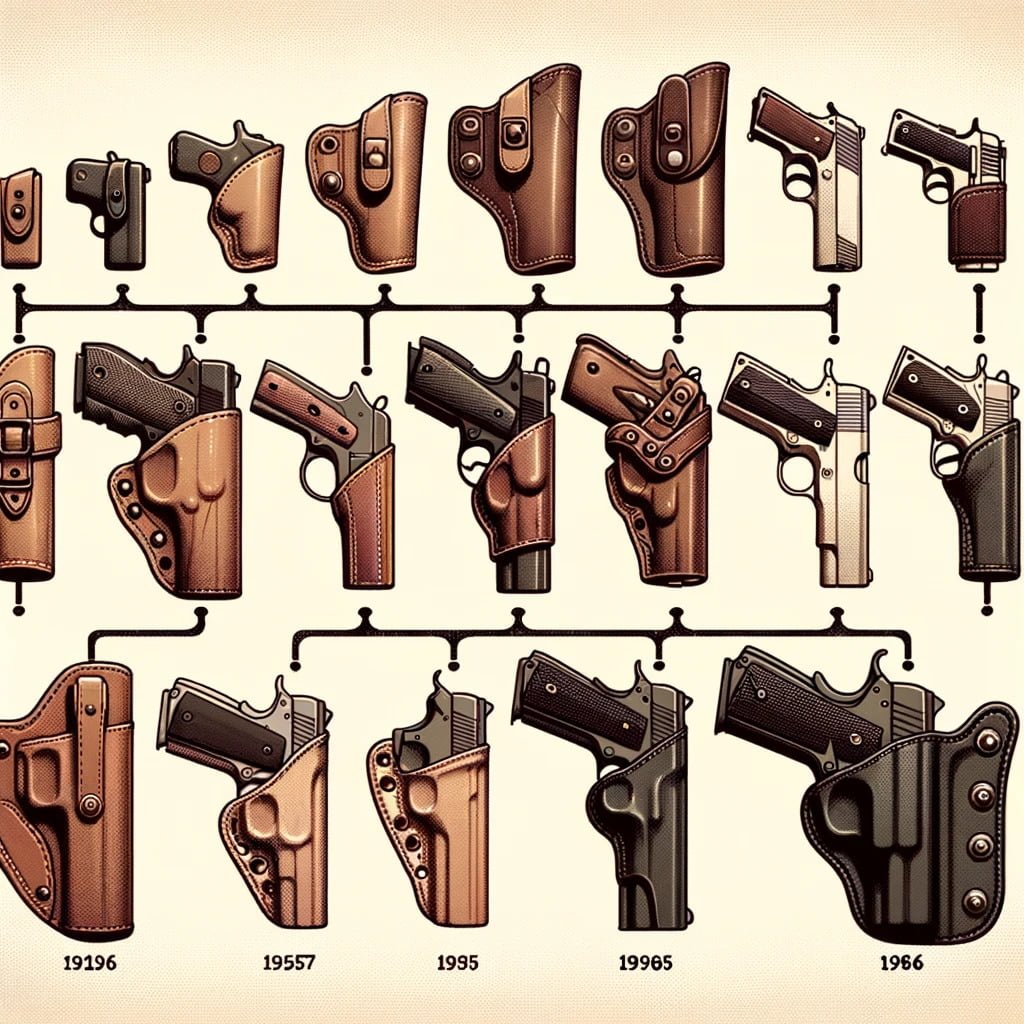
Holsters have been an essential part of firearm history. In the early days, they were simple leather pouches that hung from a belt. As time progressed and the need for quick access and security became paramount, especially for law enforcement and military personnel, the design of holsters evolved.
Leather holsters, especially the leather retention holster, were among the first to offer a level of security. They were crafted to fit the shape of the firearm, ensuring it stayed in place. Over time, with the advent of new materials and technologies, holsters have become more advanced, offering varying levels of retention and accessibility.
How Does a Retention Holster Work?
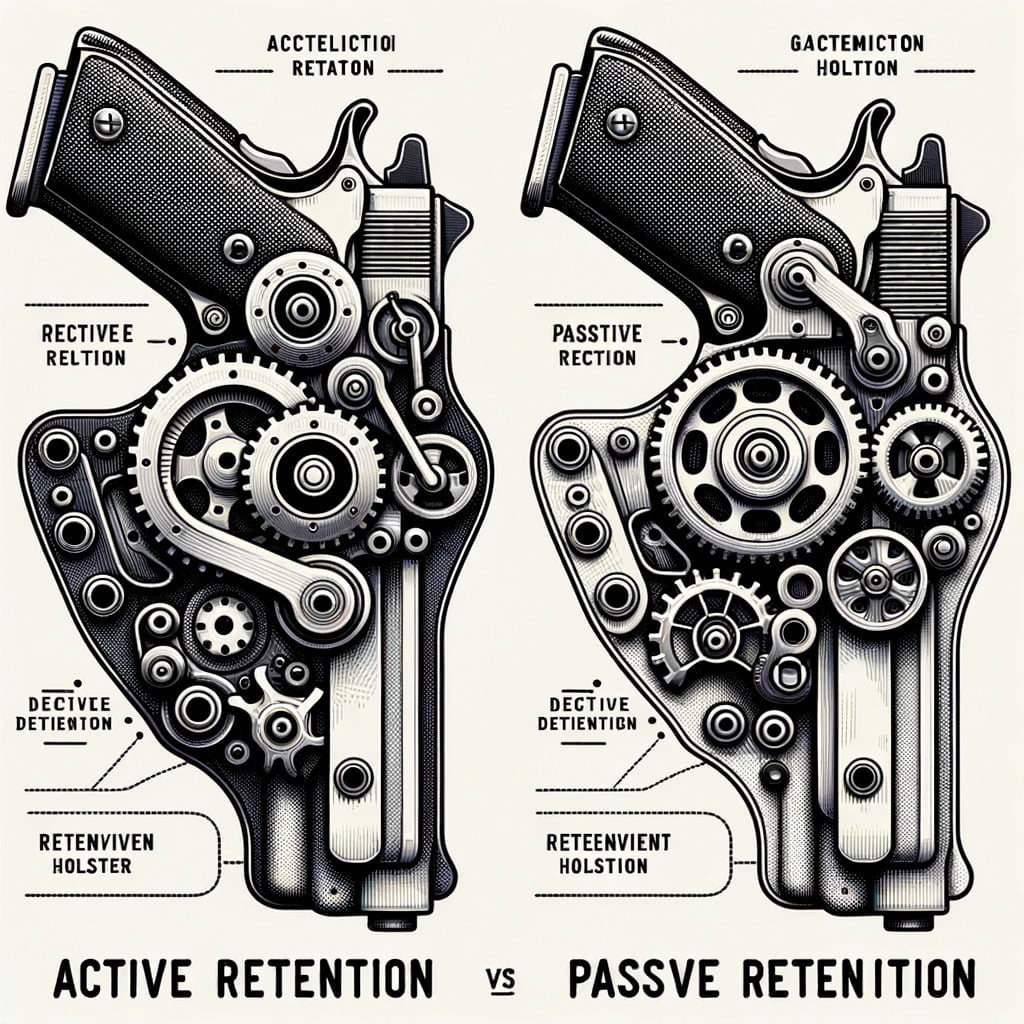
A retention holster is designed to keep the firearm securely in place until the user intentionally draws it. There are two main types of retention mechanisms:
Active Retention Holster: This type of holster requires the user to perform a specific action to release the firearm, such as pressing a button or releasing a strap. It adds an extra layer of security, ensuring that only the person wearing the holster can easily draw the firearm.
Passive Retention Holster: This design relies on the natural fit and grip of the holster material on the firearm. The snug fit ensures that the firearm stays in place during regular activities but can be drawn easily when needed.
Whether you choose an active or passive retention system, it’s crucial to find a holster that fits both your firearm and your needs perfectly.
Passive and Active Retention Holsters
When it comes to firearm safety and accessibility, the design of the holster plays a pivotal role. Retention holsters, in particular, are designed to securely hold the firearm in place. There are two primary categories of retention mechanisms:
- Passive Retention: This is the natural ability of the holster to hold the firearm in place without any additional locking mechanisms. It relies on the snug fit of the holster material around the firearm. Think of it like a well-fitted glove; the firearm stays securely in place due to the tight fit but can be easily drawn when needed.
- Active Retention Holsters: These holsters come equipped with specific mechanisms or devices that need to be manually disengaged to draw the firearm. Examples include thumb breaks, buttons, or straps. These added features ensure an extra layer of security, especially in situations where there’s a risk of someone else trying to access the firearm.
Types of Retention Holsters
The world of holsters is vast, with designs catering to different firearms, carrying positions, and specific needs. Here’s a brief overview:
Handgun Holster Types: These are designed specifically for handguns and can range from pocket holsters to shoulder rigs. The design varies based on where on the body the firearm is carried.
Types of Pistol Holsters: Pistol holsters often come in designs like inside-the-waistband (IWB), outside-the-waistband (OWB), appendix carry, and more. Each type offers different advantages in terms of concealment, comfort, and accessibility.
Types of Glock Holsters: Given the popularity of Glock pistols, there are holsters tailored specifically for various Glock models. These can range from minimalist clip designs to more robust duty holsters with multiple retention mechanisms.
Holster System: This refers to the overall design and functionality of the holster. Some systems are modular, allowing users to switch between different carrying positions or adjust retention levels.
Friction-based Retention
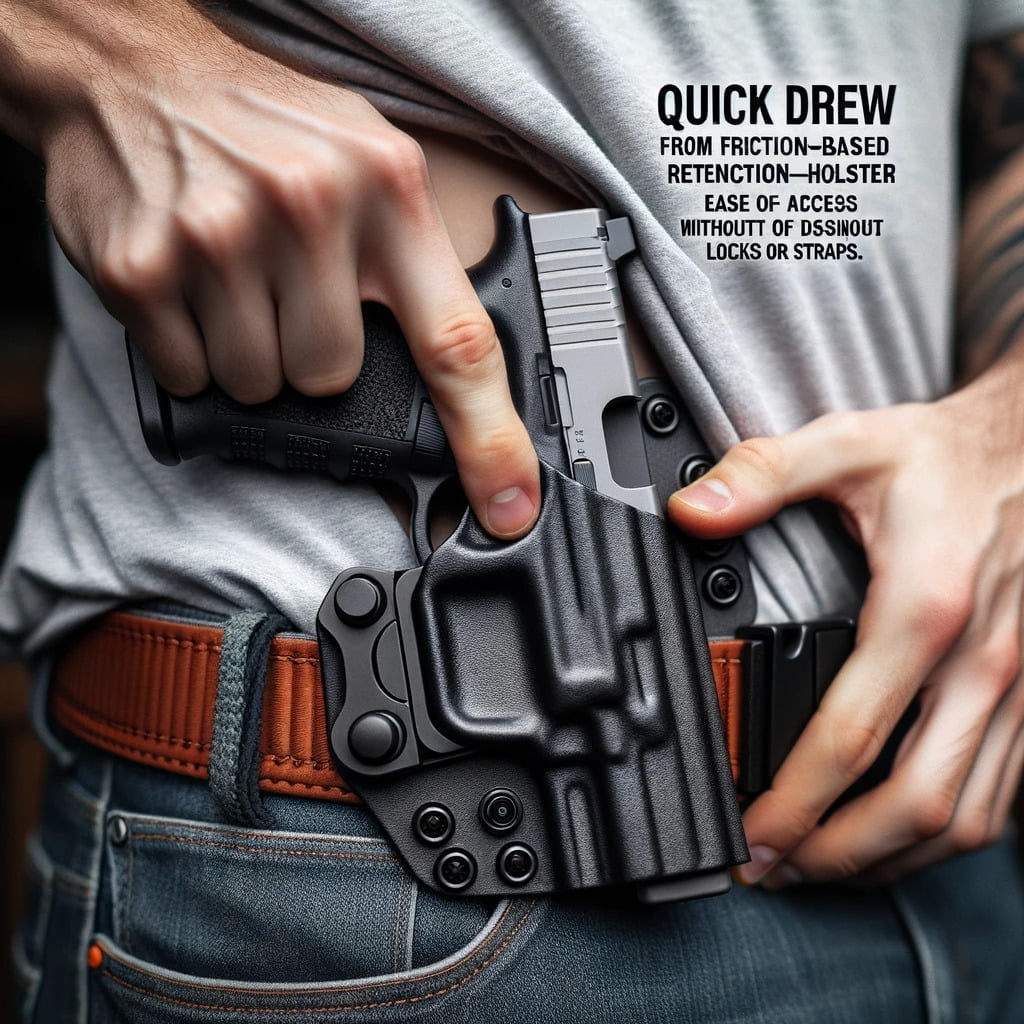
Diving a bit deeper into the realm of passive retention, friction-based retention is a fascinating concept. It’s all about the balance between security and accessibility. The holster material, often leather or a molded polymer, is designed to grip the firearm tightly.
This grip, or friction, ensures the firearm stays put during daily activities, from walking to running. The beauty of this system is its simplicity. There’s no need for additional locks or straps; the holster’s design and the firearm’s contours work together to create a secure yet accessible carrying solution.
It’s an elegant solution for those who prioritize quick draw times but still want the peace of mind that their firearm won’t accidentally dislodge.
Thumb Breaks and Strap Mechanisms
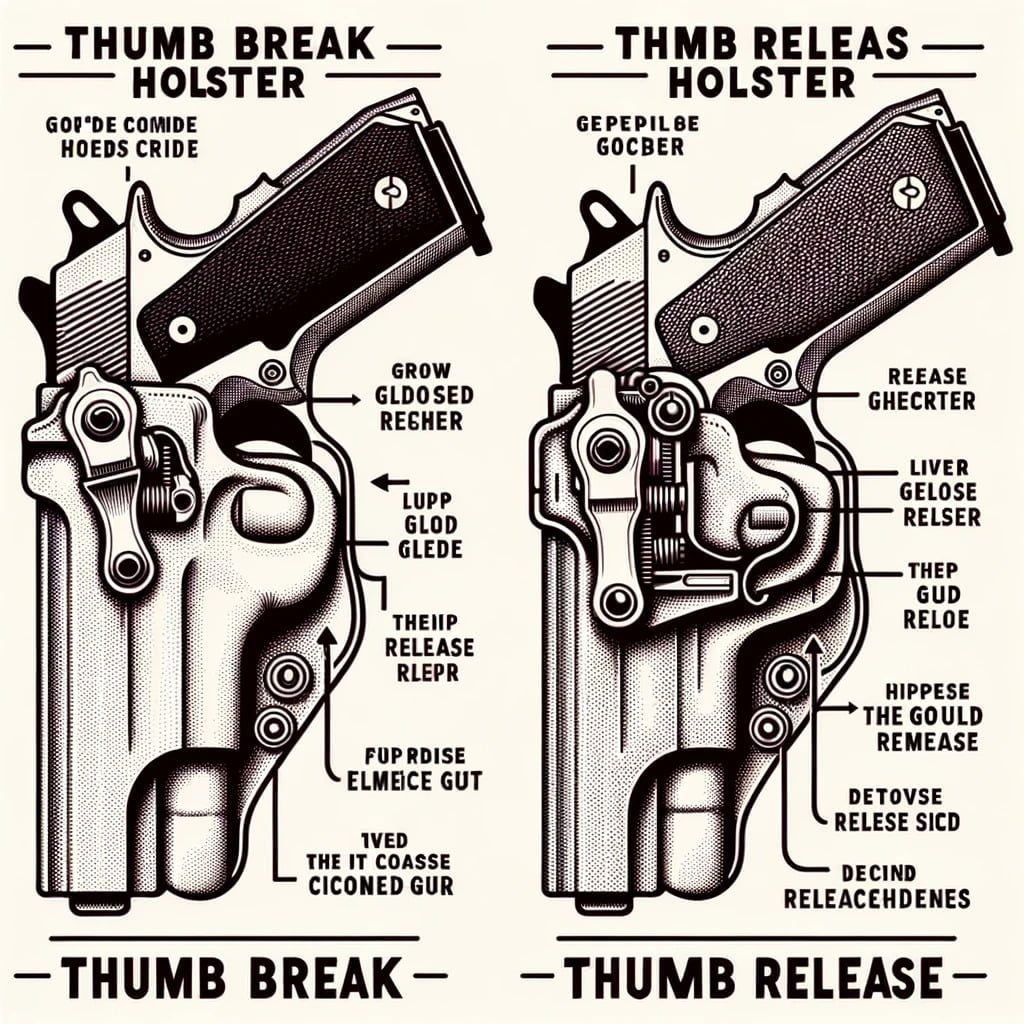
When discussing holsters, the term “thumb break” often comes up. But what is a thumb break on a holster? Essentially, a thumb break is a safety strap on the holster that goes over the back of the firearm’s grip.
To draw the firearm, the user must use their thumb to “break” or snap open this strap, hence the name “thumb break holster.” This design ensures an added layer of security, preventing the firearm from accidentally falling out or being easily grabbed.
Another variant in this category is the “thumb release holster,” which uses a mechanism that requires the thumb’s pressure to release the firearm.
Hood or Guard Systems
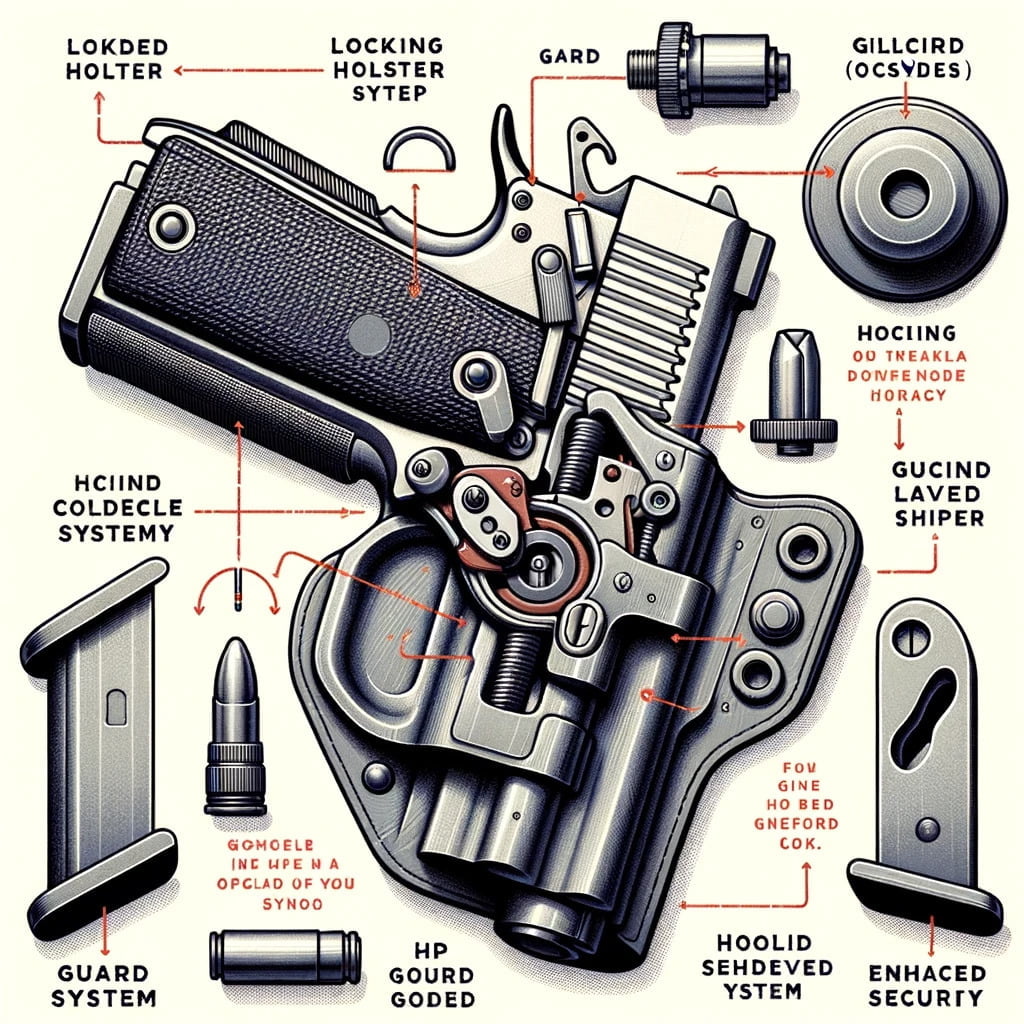
For those looking for an even higher level of security, holsters with hood or guard systems come into play. These locking holsters often feature a protective hood or guard that covers the back of the firearm’s slide or hammer. To draw the firearm, the user must disengage this lock, making it a holster with lock or, more commonly, a locking gun holster.
This system is particularly popular among law enforcement officers, ensuring that their firearm remains secure even in physical altercations.
Combination Systems
For the utmost in firearm security, combination systems are the pinnacle. These holsters combine multiple retention mechanisms. A double retention holster might feature both a thumb break and a locking system. Meanwhile, a triple retention holster could add an additional strap or mechanism into the mix.
These holsters are often referred to by their retention levels, such as a level 2 holster (two retention mechanisms) or a level 3 holster (three retention mechanisms).
For specific firearms, like the Glock 19, you might come across terms like “level 3 holster for Glock 19” or “Glock 19 holster level 3.”
In the world of concealed carry, the term “tier 1 holster” or “tier one holster” often pops up. This doesn’t necessarily refer to a specific retention level but rather to the holster’s quality and design. A tier 1 concealment holster is top-of-the-line, offering both security and comfort.
Whether you’re looking for a simple leather retention holster or a level 4 holster with multiple security mechanisms, understanding the terminology and functionality is essential. After all, the right holster ensures both the safety of the user and those around them.
Levels of Retention Holsters
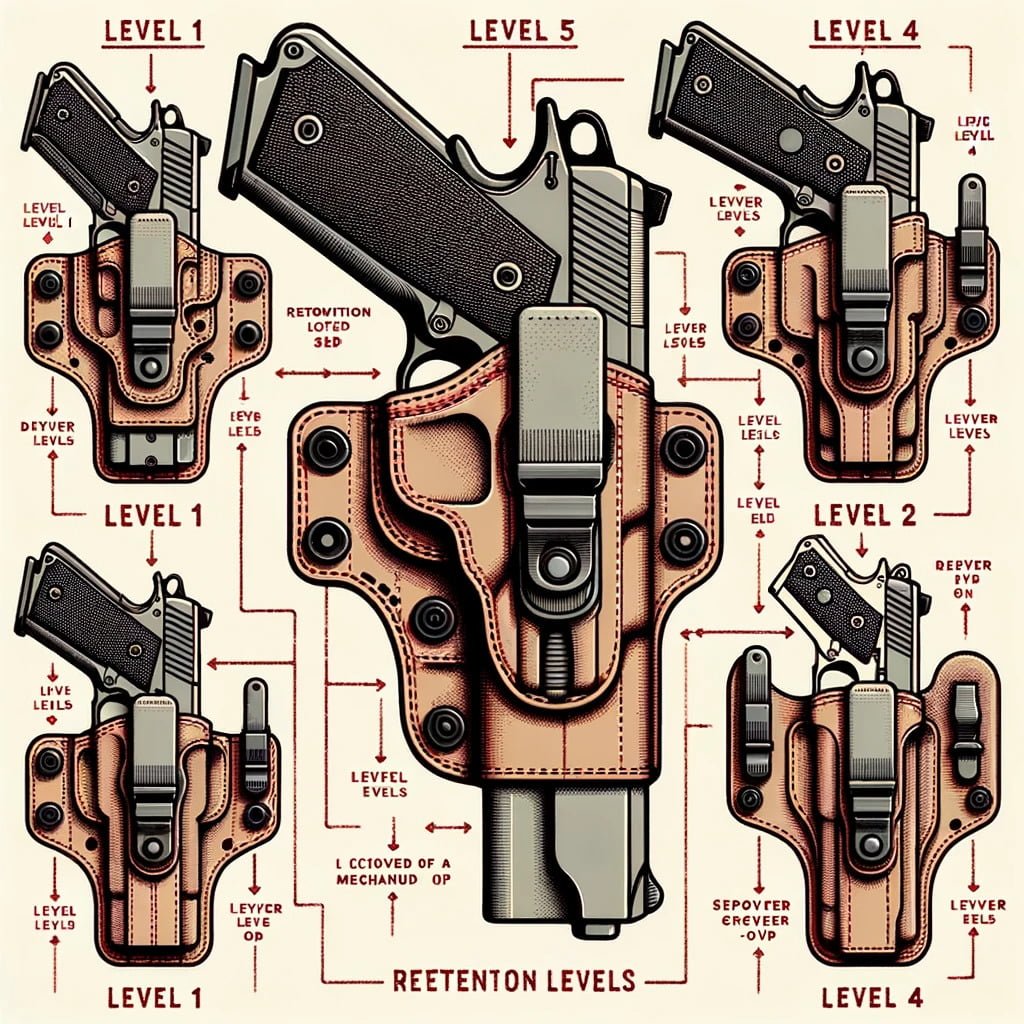
When it comes to ensuring the safety and security of your firearm, understanding the levels of retention in holsters is paramount. Whether you’re a police officer, a concealed carry enthusiast, or someone new to the world of firearms, knowing the difference between the various levels of retention can make all the difference. Let’s dive into the specifics of Level 1 and Level 2 retention holsters and see how they stack up.
What is a Level 1 Retention Holster?
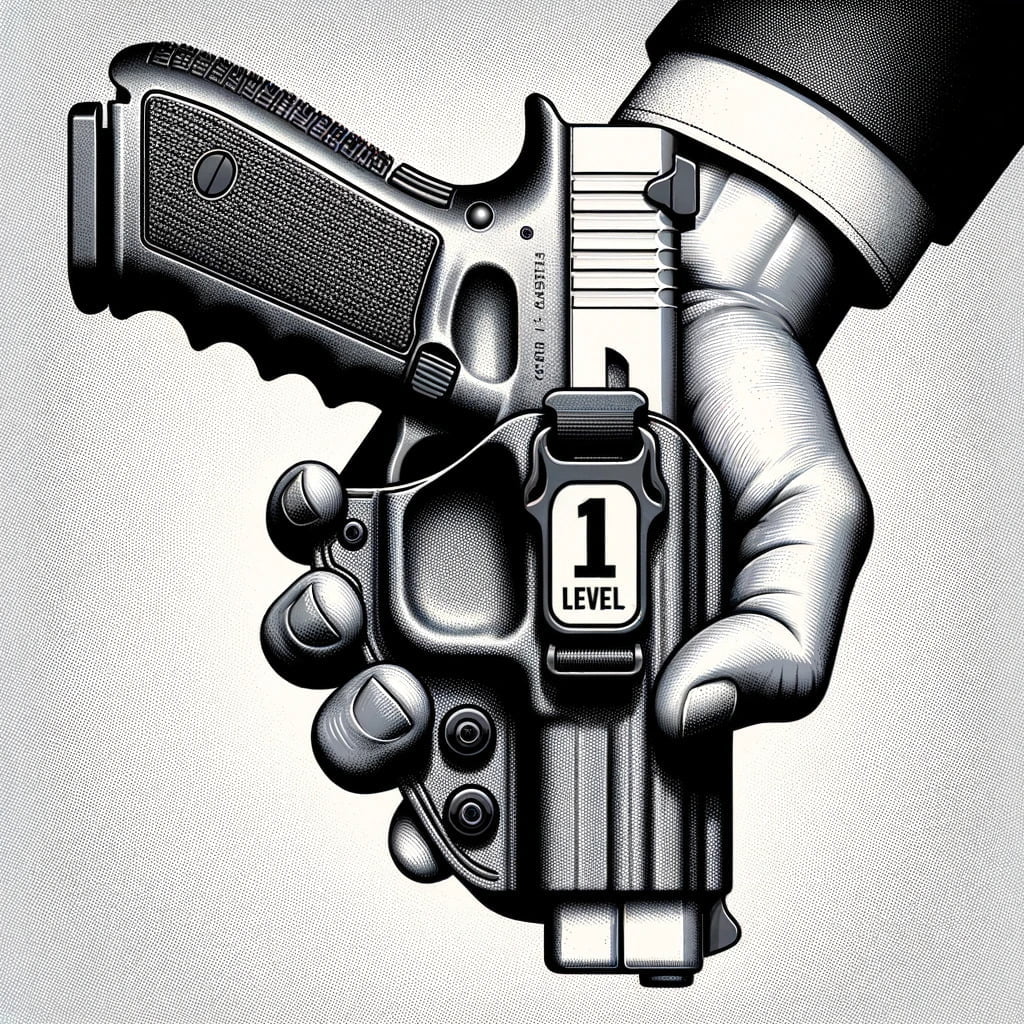
A Level 1 holster, often referred to as a “passive retention” holster, primarily relies on the snug fit of the gun in the holster to keep it secure. This type of holster is designed to hold the gun firmly without the need for any additional locking mechanisms. The primary advantage of a Level 1 holster is its simplicity and speed. With no locks or straps to fiddle with, drawing your gun is quick and straightforward.
For those wondering, “what is a holster?” At its most basic, a holster is a holder for carrying a handgun or other firearm, typically made of leather and worn on a belt or under the arm. The gun in the holster should be easily accessible, yet secure enough to prevent any accidental discharges or unauthorized access.
However, while the glock 19 level 2 holster is gaining popularity, many still prefer the simplicity of the Level 1 holster for their Glock 19. But, if you’re looking for something with a bit more security, you might want to consider the next level up.
What is a Level 2 Retention Holster?
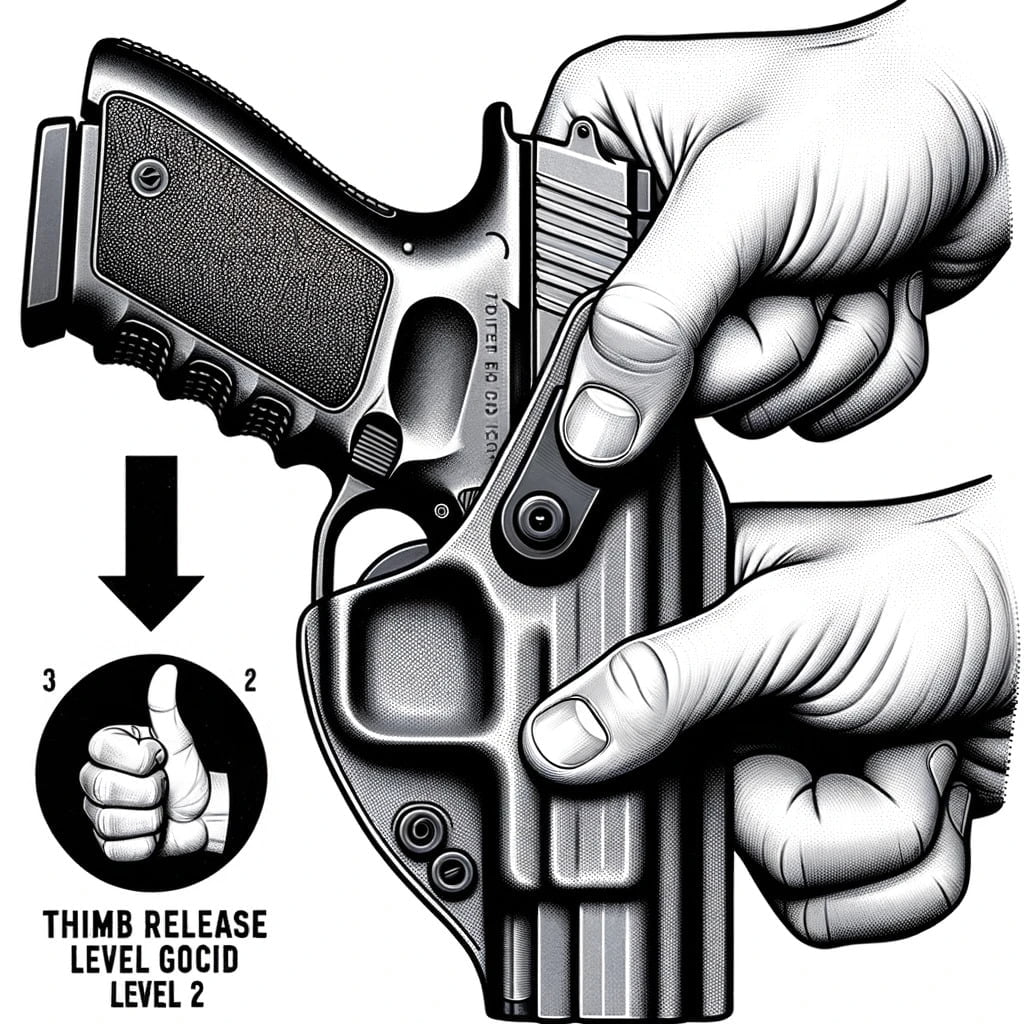
Stepping up from the basic design of the Level 1, the Level 2 retention holster introduces an additional mechanism to secure the firearm. One of the most common features in this category is the thumb break holster. This design includes a strap that goes over the back of the gun’s grip, which the user must disengage (or “break”) with their thumb to draw the firearm. Another popular feature is the thumb release holster, which requires a simple thumb action to release the gun.
For those who prioritize security, especially police officers, the Level 2 holster offers an added layer of protection against potential threats. Imagine a scenario where a police officer is in a scuffle, and someone tries to grab their gun. The police holster with Level 2 retention can prevent unauthorized access, ensuring the firearm stays where it should.
For Glock enthusiasts, the level 2 holster glock 19 and glock 19 level 2 holster are popular choices. But for those looking for even more security, there are level 3 holsters, like the level 3 holster glock 19 and level 3 glock 17 holster, which offer multiple locking mechanisms.
From handgun holster types to the various types of pistol holsters available, your choice should align with your needs, ensuring both safety and accessibility. As firearm enthusiasts often say, the best holster is the one that offers a perfect balance between speed and security.
What is a Level 3 Retention Holster?
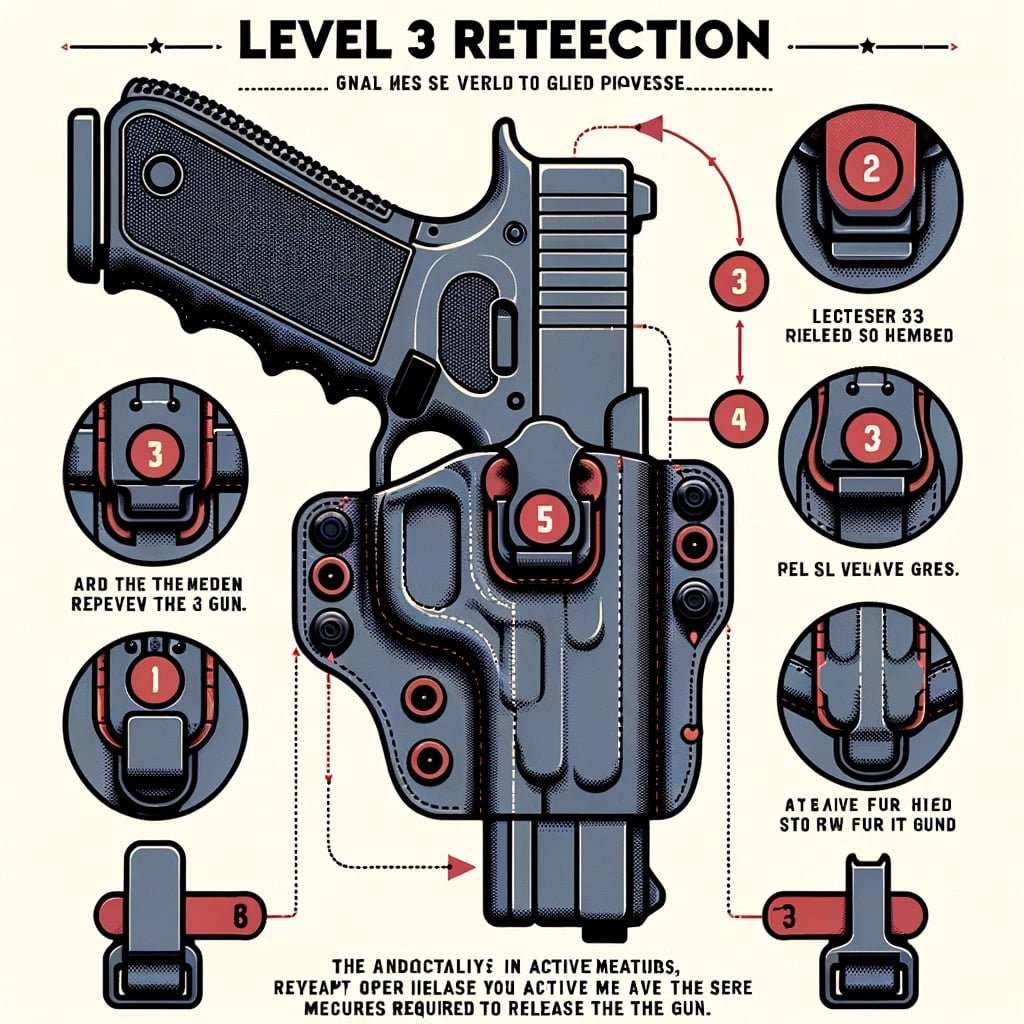
The world of holsters is vast and varied, and as we climb the ladder of holster retention, we encounter the Level 3 retention holster. So, what sets it apart? A Level 3 gun holster typically incorporates three separate mechanisms to secure the firearm.
This could be a combination of a thumb break, a trigger guard lock, and perhaps a hood over the back of the gun. The primary advantage of this design is the enhanced security it offers, especially in high-risk situations.
For many in law enforcement, the level 3 duty holster has become a standard. It provides the assurance that the firearm won’t be easily accessed by anyone other than the wearer.
When you hear the term active retention holster, it often refers to these types of holsters, where active measures (like pressing a button or lever) are required to release the gun.
What is a Level 4 Retention Holster?
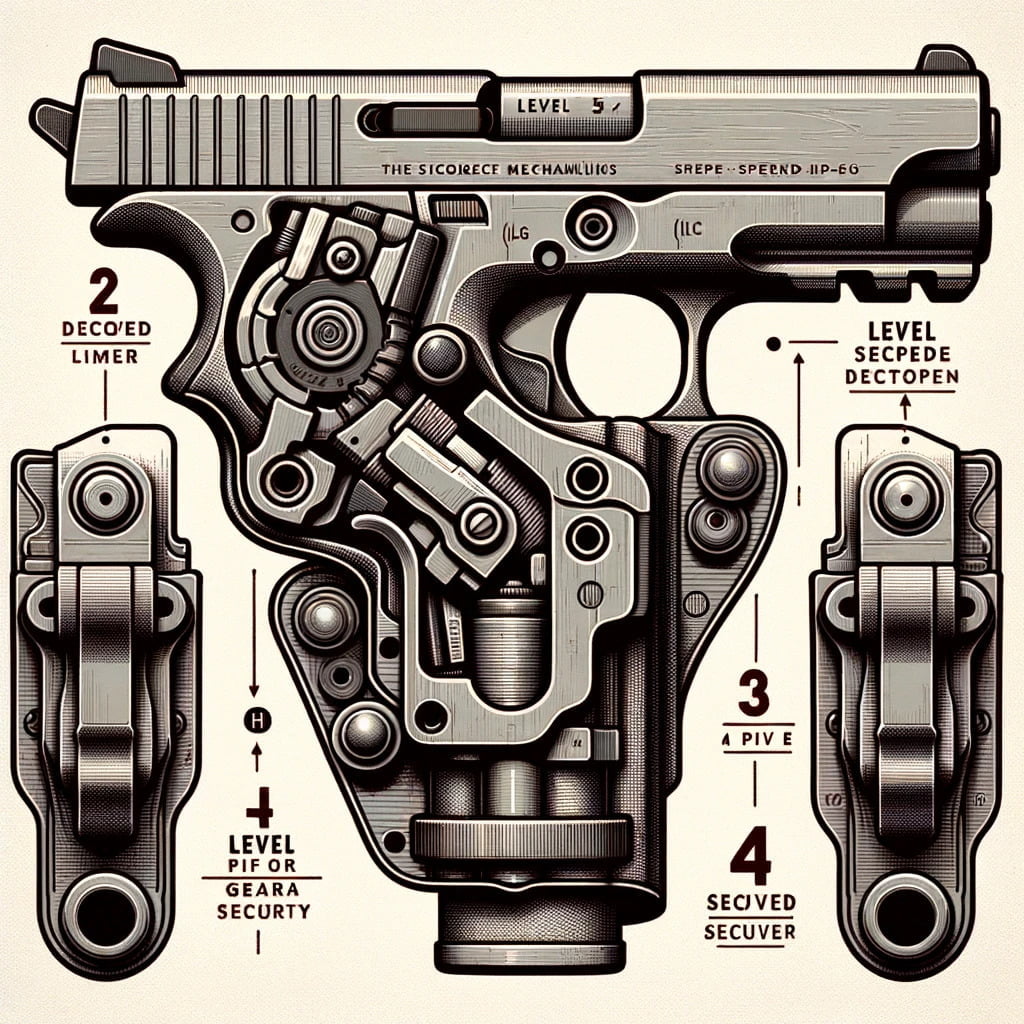
Taking security up another notch, we have the Level 4 retention holster. As the name suggests, this holster design incorporates four mechanisms to ensure the firearm is held securely. The level 4 retention holster is for those who demand the utmost in security, often used in situations where the risk of someone trying to take the firearm is exceptionally high.
While the holster levels increase, it’s essential to understand that with added security can come a slightly slower draw time. However, for many, the peace of mind offered by a double retention holster or even a quadruple one is worth the trade-off.
Level 1 vs Level 2 Retention Holster
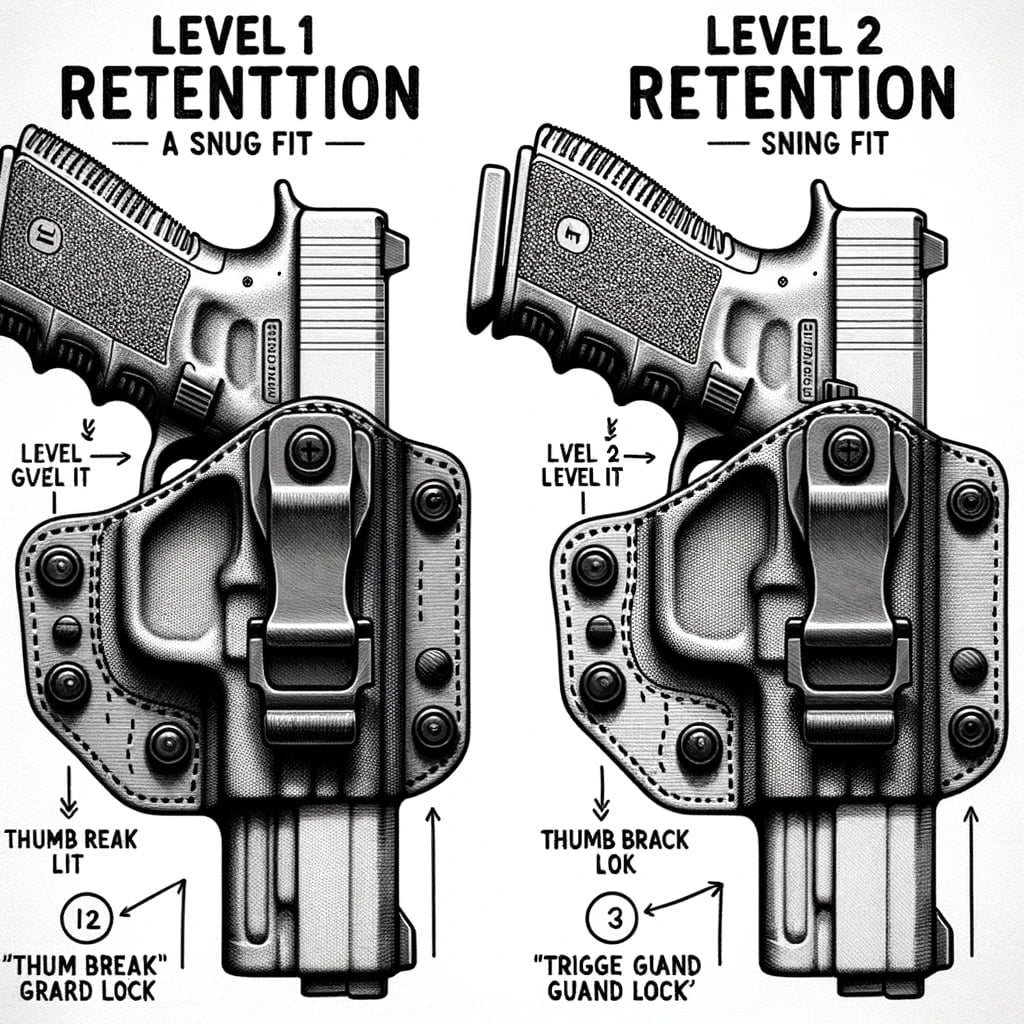
When comparing Level 1 and Level 2 holsters, the primary difference lies in the number of mechanisms used to secure the firearm. A Level 1 holster, often made from materials like leather, relies mainly on the snug fit of the gun for retention. On the other hand, a Level 2 retention holster introduces an additional mechanism, such as a thumb break or a trigger guard lock.
For those who might be wondering, “what is a retention holster?” – it’s a holster designed to hold the firearm securely, preventing unintentional removal or access by potential threats. The retention holster levels indicate the number of mechanisms or features that contribute to this security.
For Glock 17 enthusiasts, options like the level 2 holster glock 17, glock 17 level 2 holster, and level 2 glock 17 holster are popular choices. These holsters provide a balance between quick access and security, making them a favorite among many gun owners.
For everyday carry where the risk of someone trying to grab your firearm is low, a leather holster with retention at Level 1 might suffice. However, for those in professions like law enforcement, where the stakes are higher, police duty holsters with Level 2 or even higher retention are often preferred.
Level 2 vs Level 3 Retention Holster
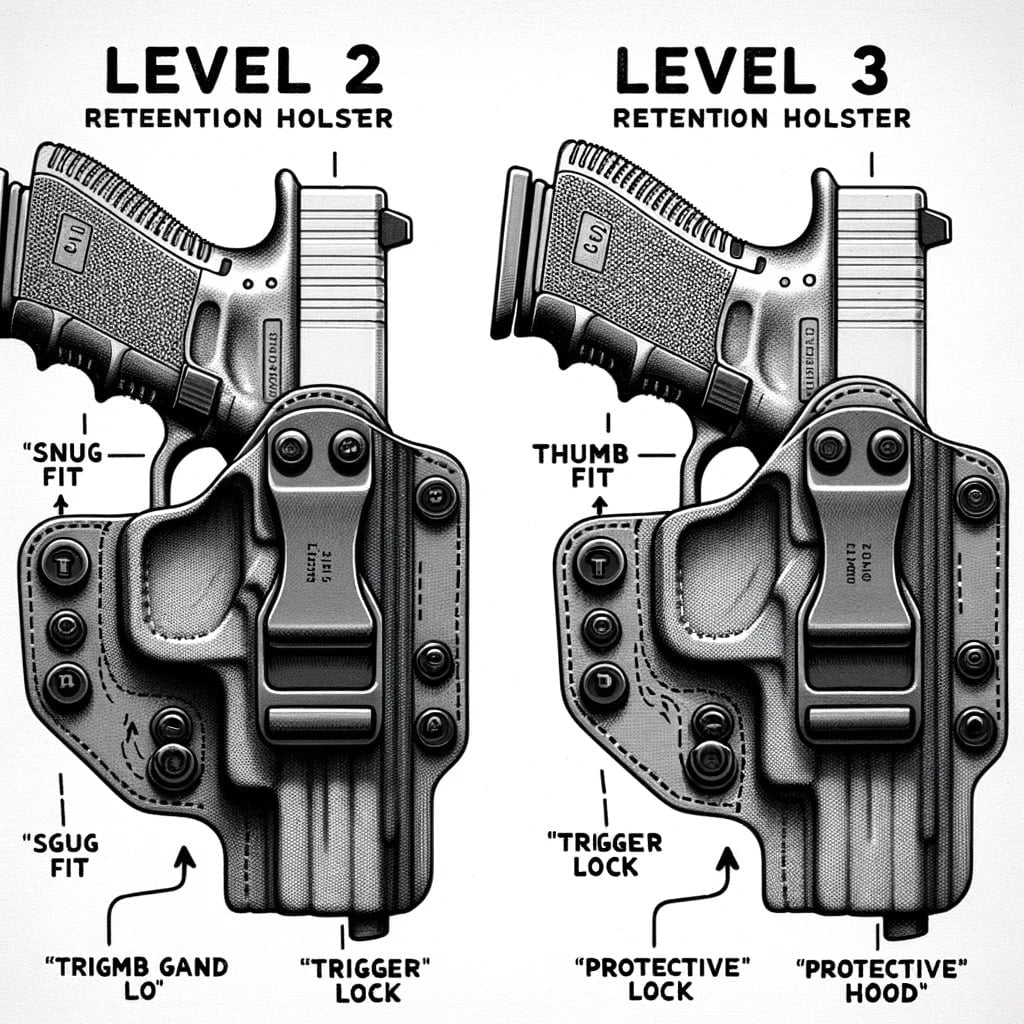
In the realm of firearm safety and security, the debate between Level 2 vs Level 3 holsters is a hot topic. Both offer unique features, but how do they differ?
A Level 2 retention holster, as the name suggests, employs two mechanisms to secure the firearm. This could be a snug fit combined with a thumb break or a trigger guard lock. Popular among many gun enthusiasts, the level 2 iwb holster and level 2 kydex holster are examples of this category, providing a balance between security and accessibility.
On the other hand, a Level 3 retention holster takes security up a notch. It incorporates three mechanisms, which might include a thumb break, trigger guard lock, and a hood over the back of the gun. For Glock aficionados, the retention holster glock 19, level 3 holster glock 22, and glock 22 level 3 holster are prime examples of this design.
When comparing what is a level 2 holster to what is a level 3 retention holster, the primary distinction is the number of security mechanisms. While Level 2 offers quick access, Level 3 ensures enhanced security, especially in high-risk situations.
Who Should Use a Retention Holster?
Retention holsters are not just for the tactical elite or law enforcement. They’re for anyone prioritizing the security of their firearm. Whether you’re a civilian carrying for personal protection or a professional in a high-risk environment, a retention holster ensures your weapon remains inaccessible to potential threats.
For those carrying popular models like the glock 22 holster level 3 or the level 3 retention holster glock 19, the added security mechanisms can be a game-changer. And for rifle enthusiasts, the rifle retention system offers similar benefits, ensuring long guns are just as secure.
Benefits of Using a Retention Holster
Enhanced Security: The primary advantage of retention holsters, be it a level 2 gun holster or a triple retention holster, is the added security. The multiple mechanisms ensure that the firearm remains secure, reducing the risk of unintentional discharges or unauthorized access.
Versatility: With options ranging from kydex retention holster to owb retention holster, there’s a design to suit every need. Whether you prefer the alien gear rapid force level 2 or are on the hunt for the best retention holster, the market offers a plethora of choices.
Peace of Mind: Knowing that your firearm is securely holstered, especially with the best duty holsters, provides peace of mind. Whether you’re in a crowded place or a high-pressure situation, a retention holster ensures your weapon remains inaccessible to anyone but you.
Quick Access: Despite the added security, retention holsters are designed for quick and easy access. With practice, drawing from a level 2 duty holster or even a level 3 glock 22 holster becomes second nature, ensuring you can respond rapidly when needed.
In conclusion, whether you’re a seasoned professional or a civilian, understanding the benefits of retention holsters is crucial. They offer a perfect blend of security and accessibility, ensuring that you’re always prepared, no matter the situation.
Common Misconceptions about Retention Holsters
In the world of firearms and holsters, misinformation can be as dangerous as a loaded gun. Let’s debunk some common myths surrounding retention holsters:
“All Retention Holsters are the Same”: This couldn’t be further from the truth. From a level one retention holster to a level 3 glock holster, there are varying degrees of security and mechanisms involved.
“Higher Retention Means Slower Draw”: While it’s true that a level 3 retention holster glock 17 might require more steps to draw than a level ii holster, with practice, one can achieve a quick and smooth draw from any retention level.
“Only Law Enforcement Needs Retention Holsters”: Many believe that what holsters do police use are the only ones with retention. However, civilians can also benefit from the added security, especially in crowded or high-risk areas.
Choosing the Right Retention Holster
Selecting the perfect holster is a blend of understanding your needs and knowing the options available. Here’s a guide to help:
Determine Your Needs: Are you looking for a level 2 concealed carry holster for everyday use or a glock 48 level 3 holster for professional settings? Your environment and potential threats play a role.
Understand the Mechanisms: Ask yourself, how does a retention holster work? Whether it’s the level 2 retention system of a glock 43x level 2 holster or the triple-lock system of level 3 retention holsters, familiarize yourself with their operations.
Comfort & Fit: The holster system should be comfortable for extended wear, and the firearm should fit snugly.
Safety Precautions and Best Practices
Safety is paramount. Here are some guidelines to ensure you use your retention holster safely:
Regular Practice: Whether you’re using a level 3 glock 19 holster or any other type, practice drawing and holstering regularly to build muscle memory.
Maintenance: Just like your firearm, your security holster needs regular checks and cleaning. Ensure no debris interferes with the retention mechanisms.
Awareness: Always be aware of your surroundings. A police duty holster or a glock holster level 3 offers security, but situational awareness is your first line of defense.
Conclusion
Retention holsters, from types of glock holsters to specialized level 3 holster glock 23 designs, are about more than just carrying a firearm. They’re about security, accessibility, and peace of mind. Whether you’re a professional or a civilian, understanding how retention holsters work and the nuances of each level can make all the difference. In the end, the right knowledge, combined with the right equipment, ensures safety for both the wearer and those around them.

